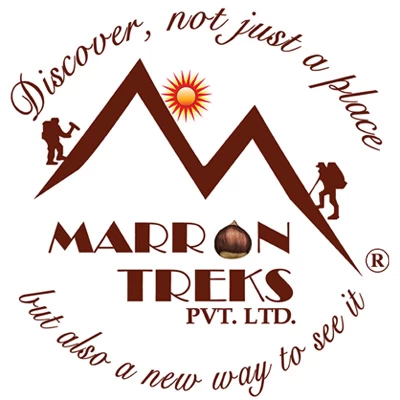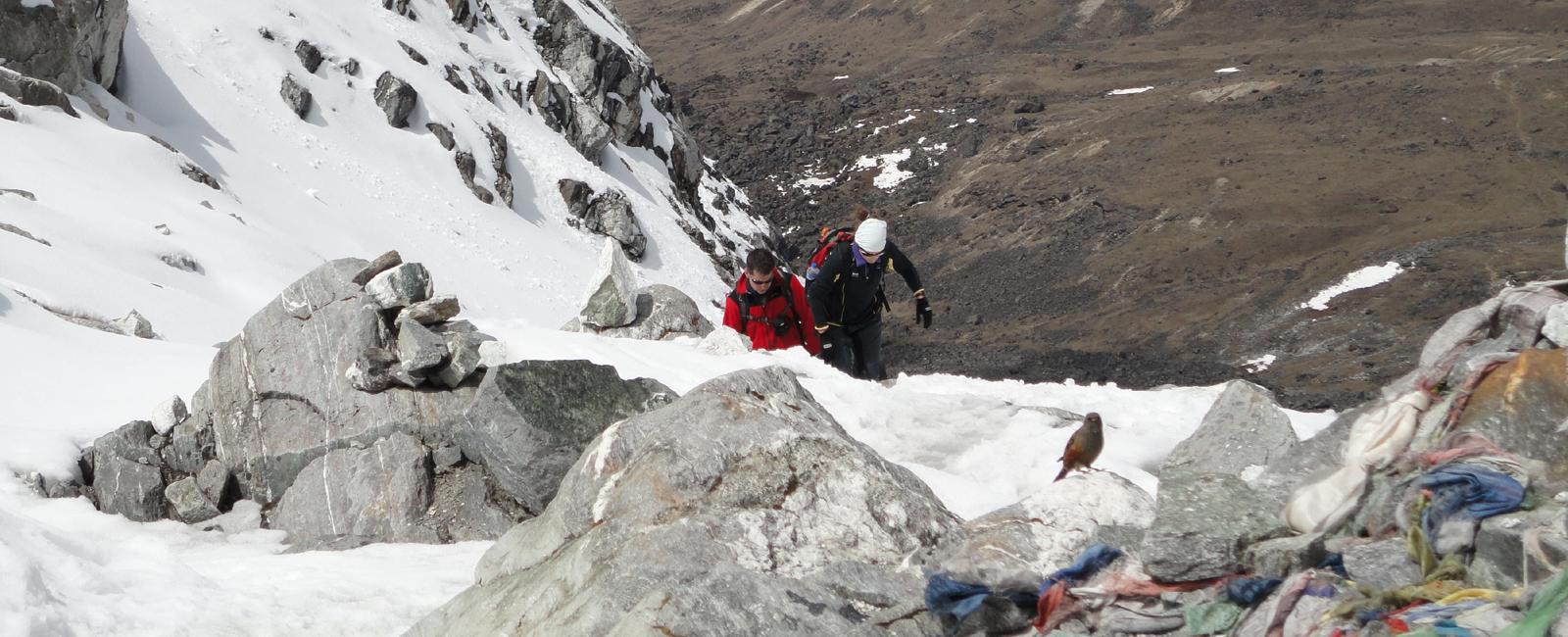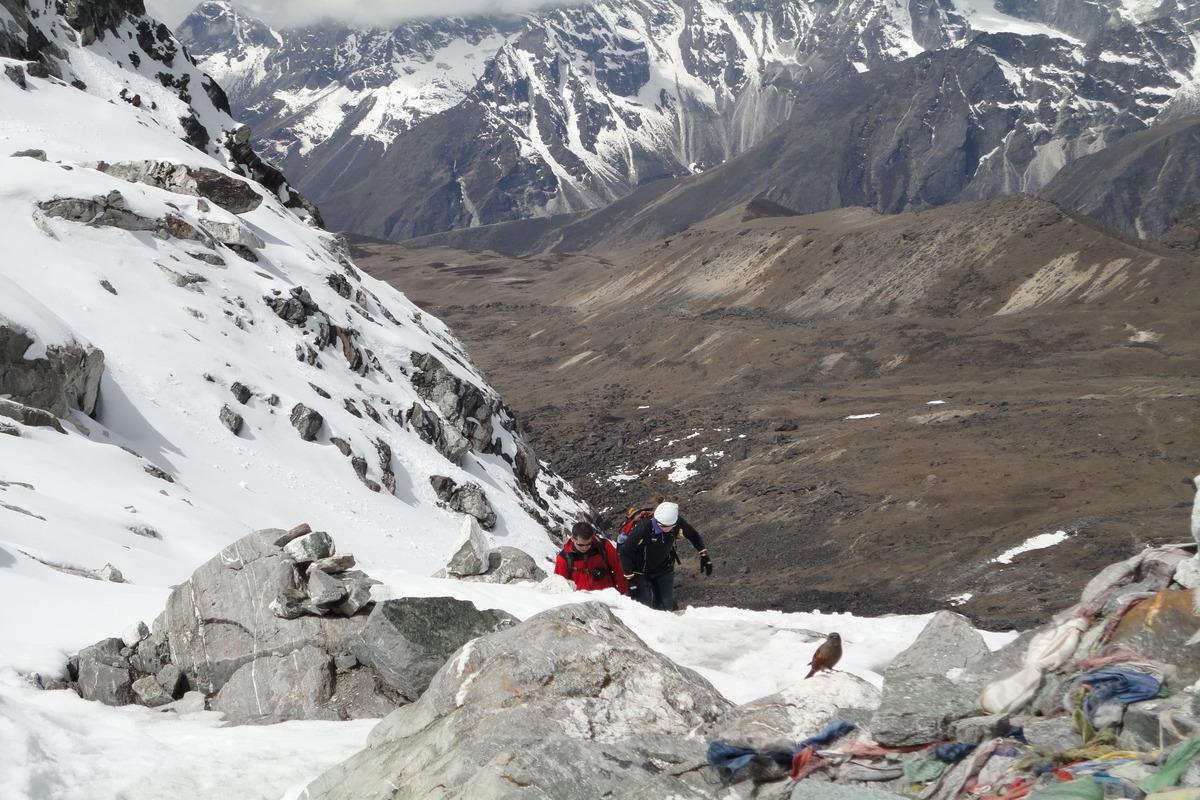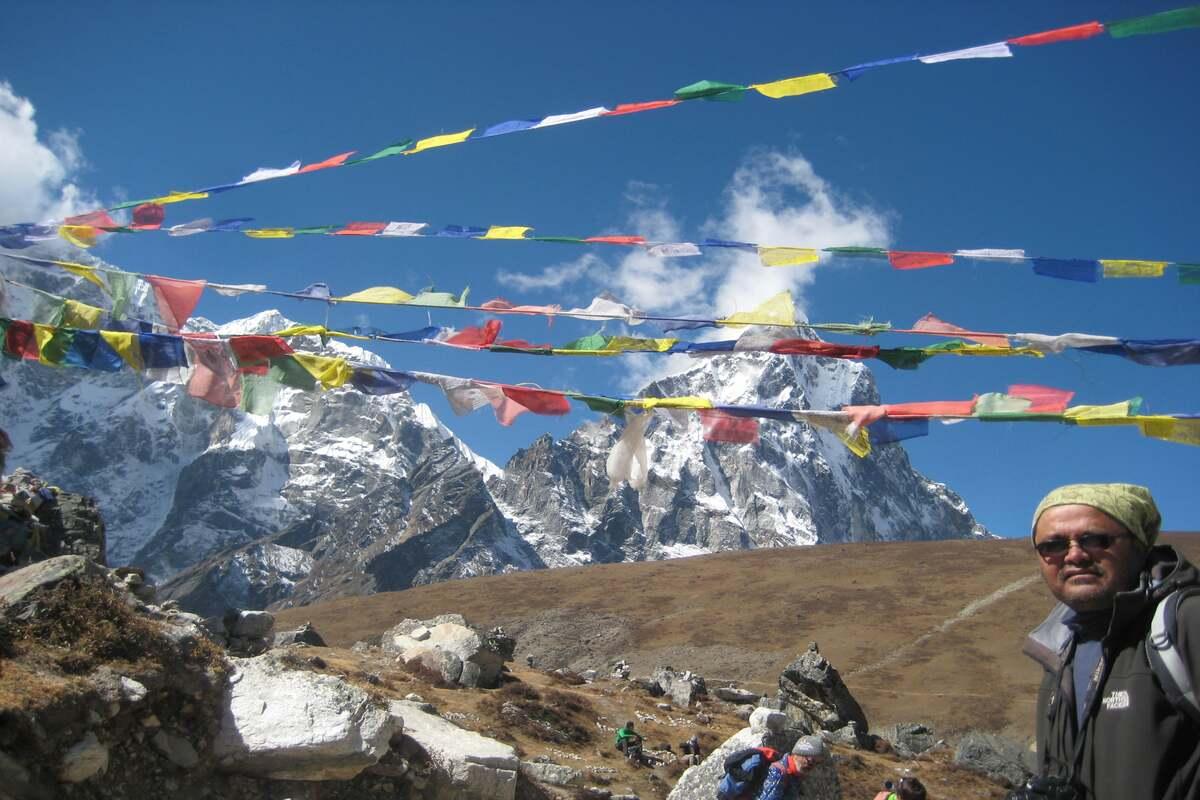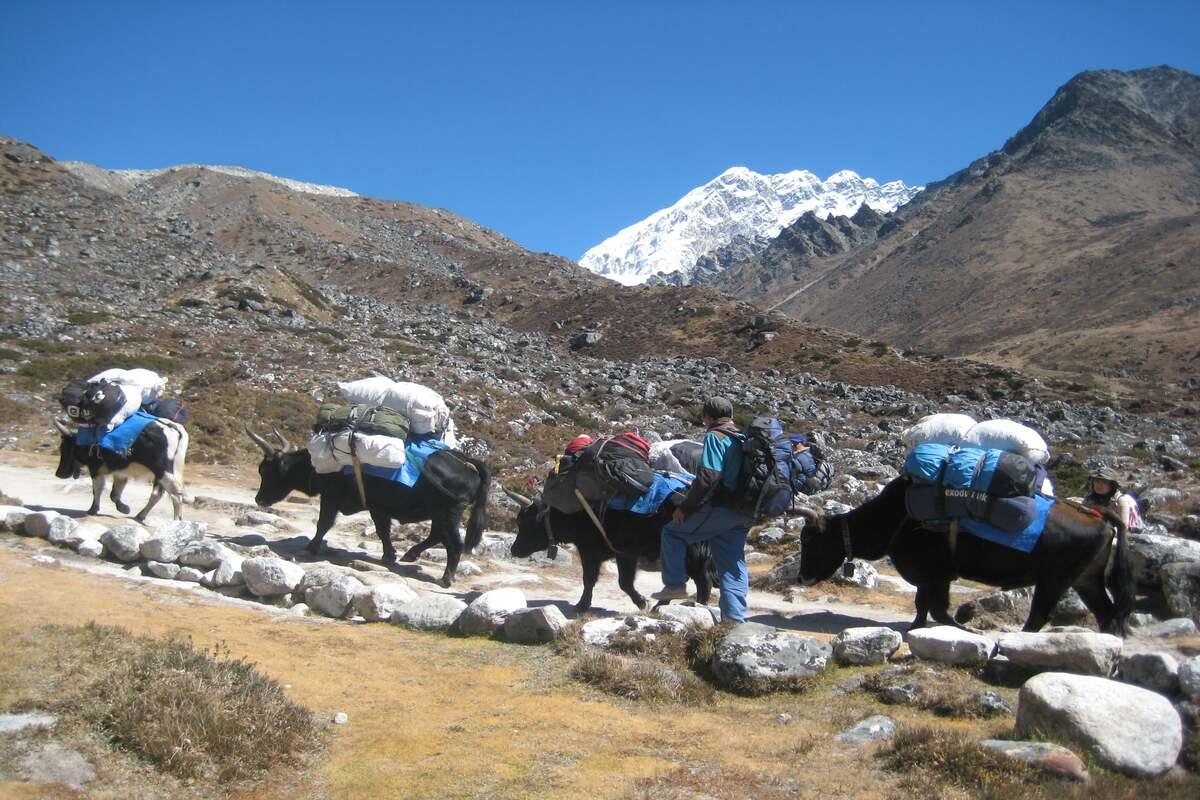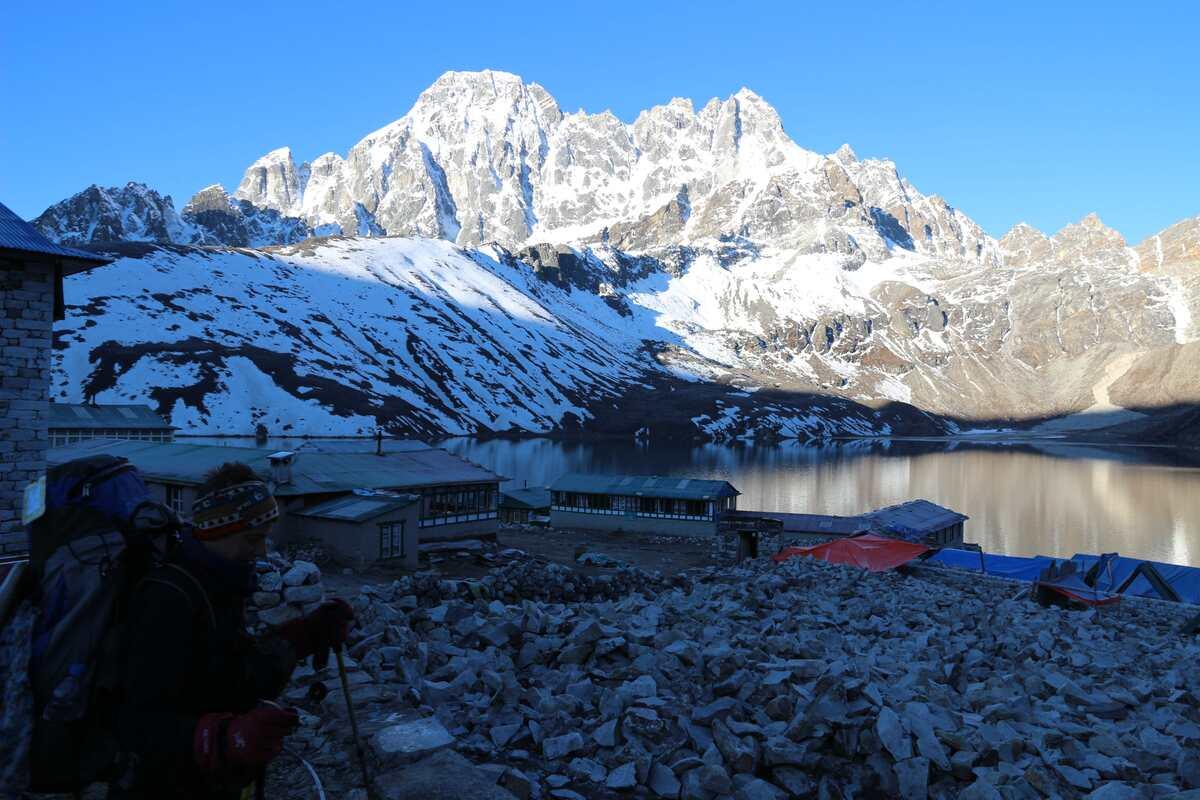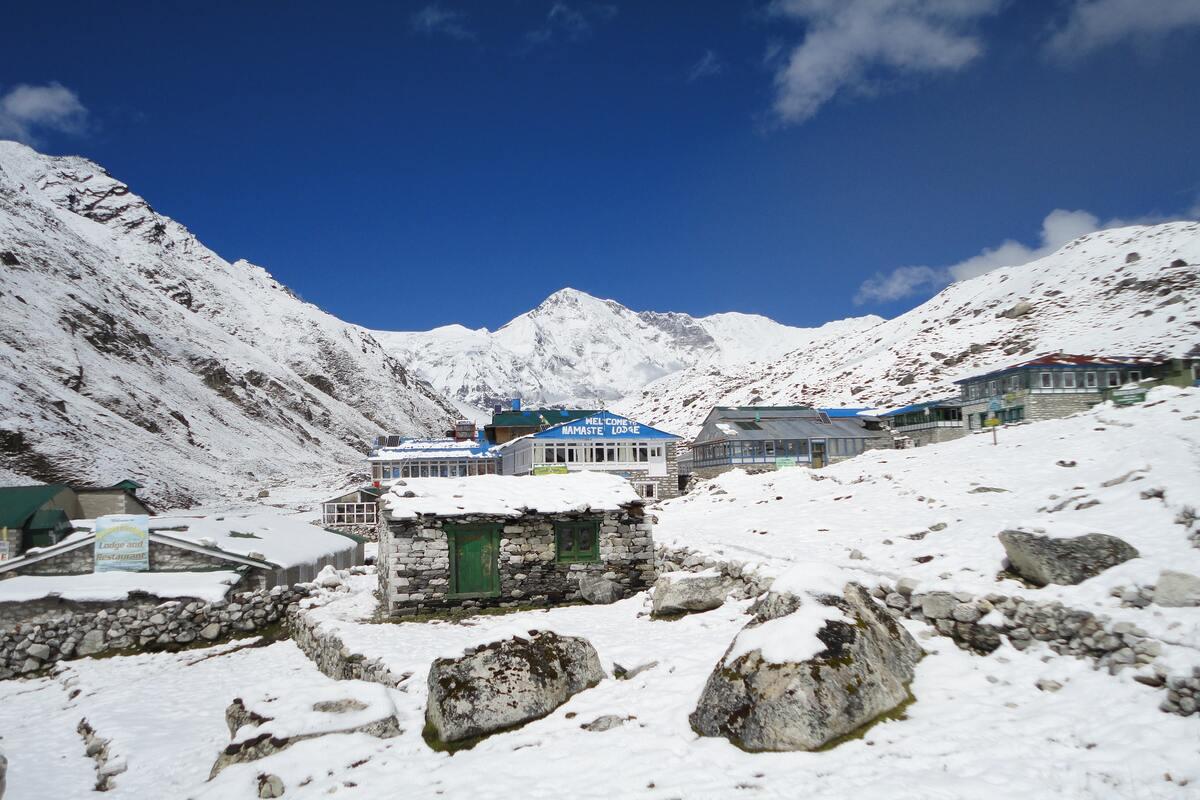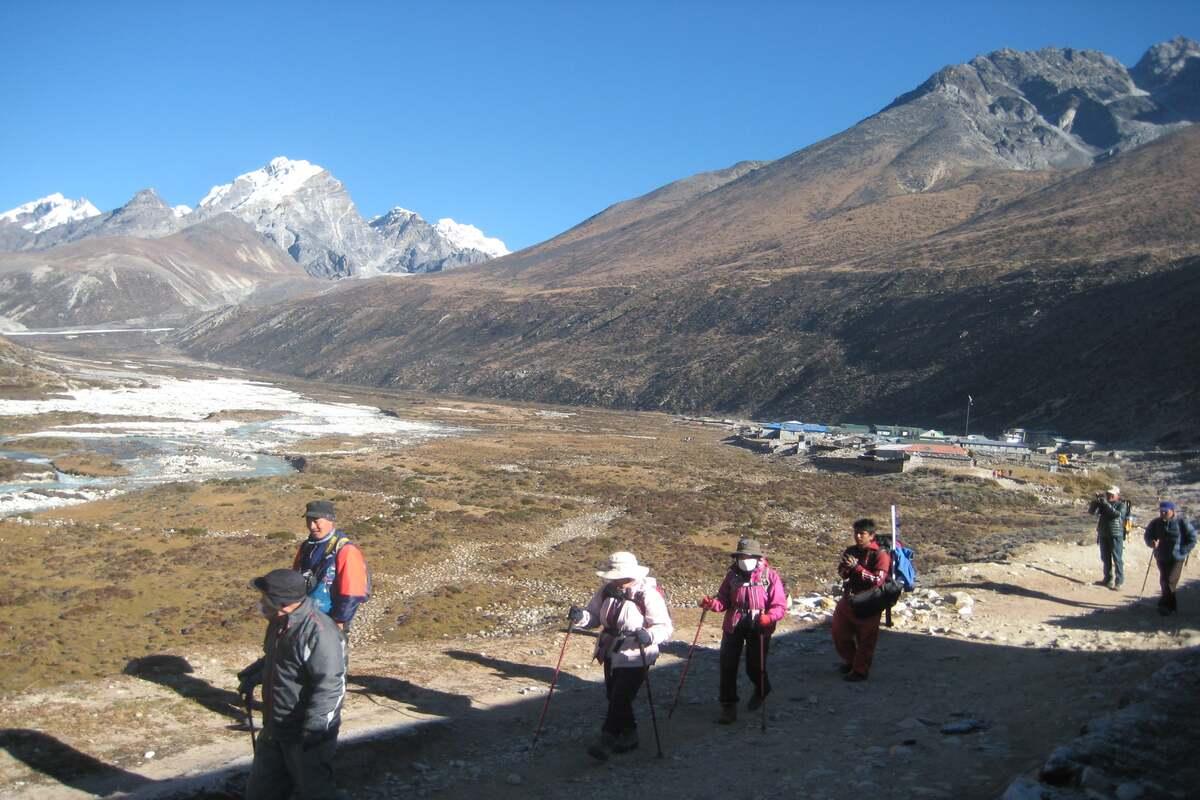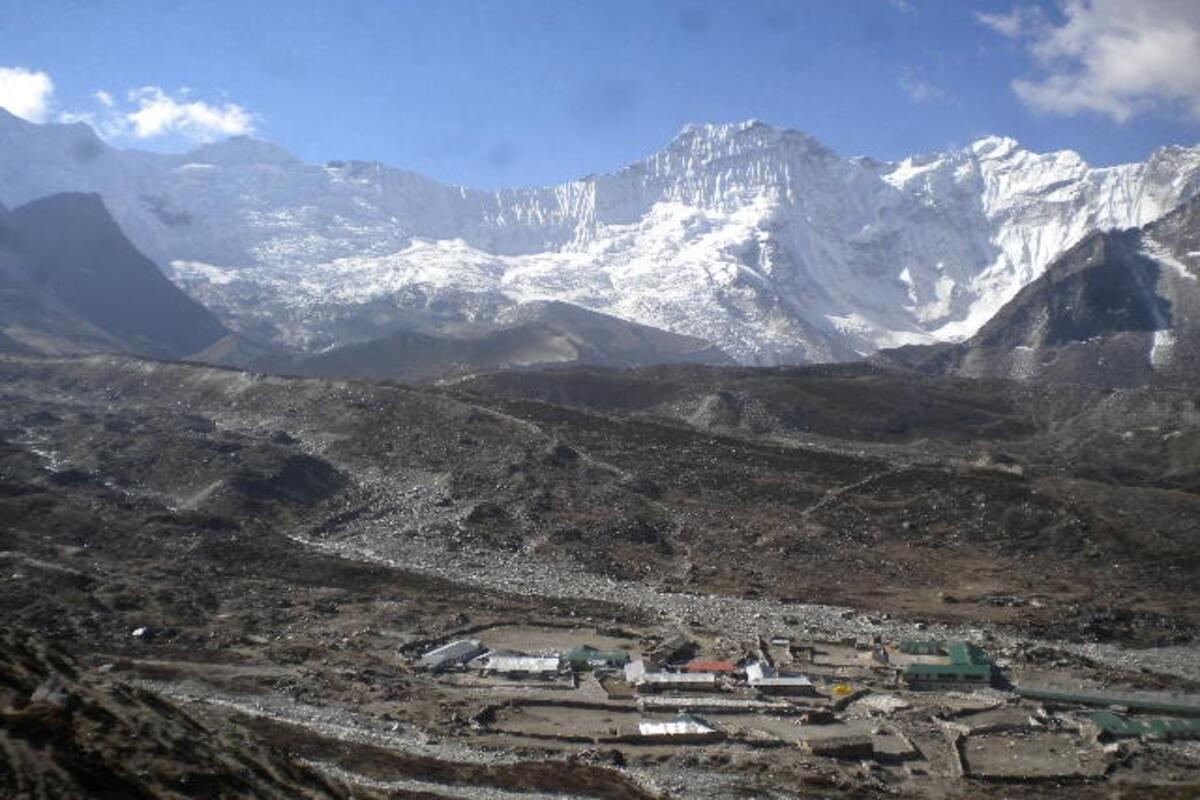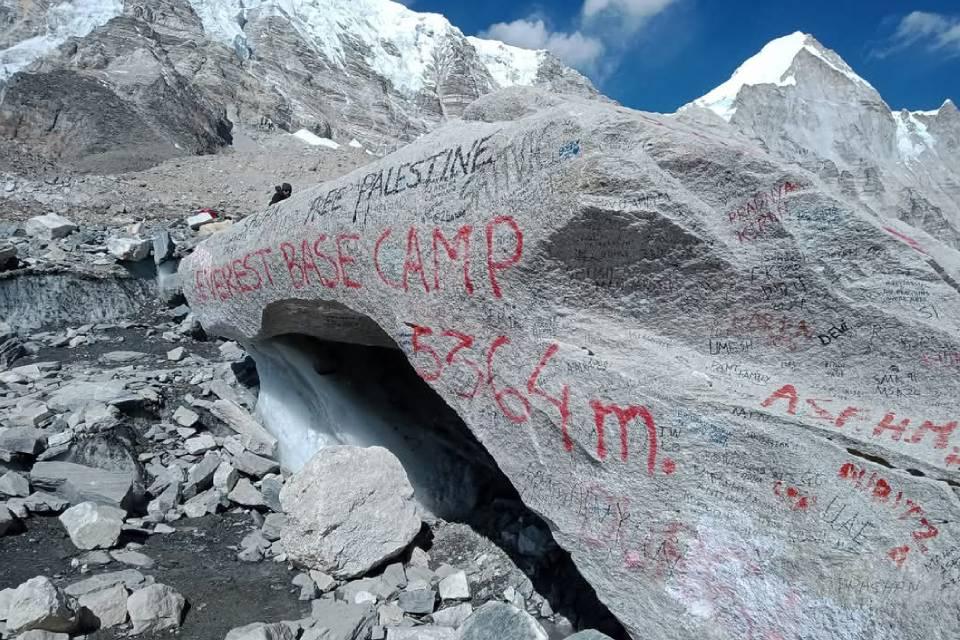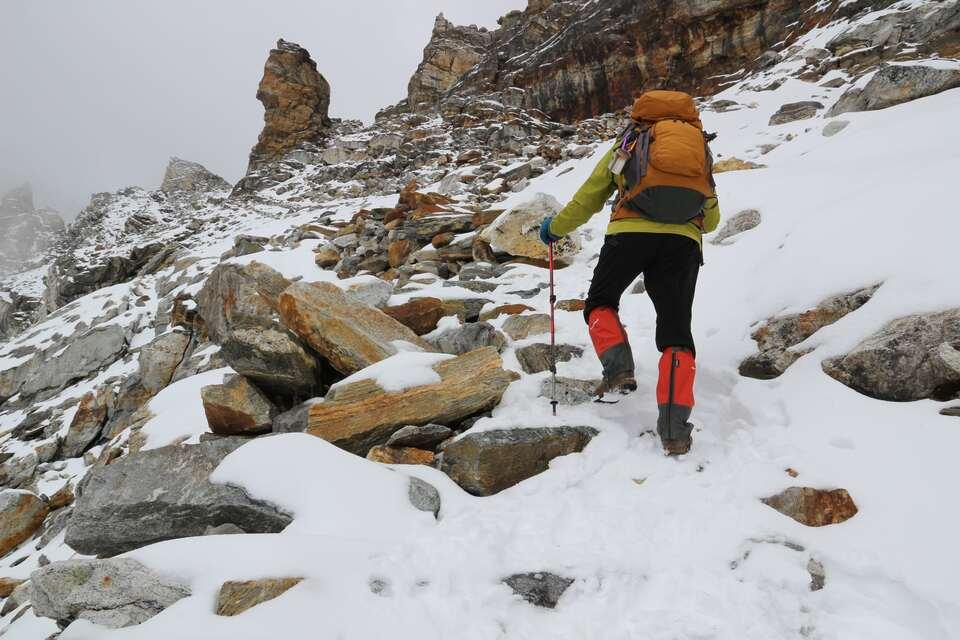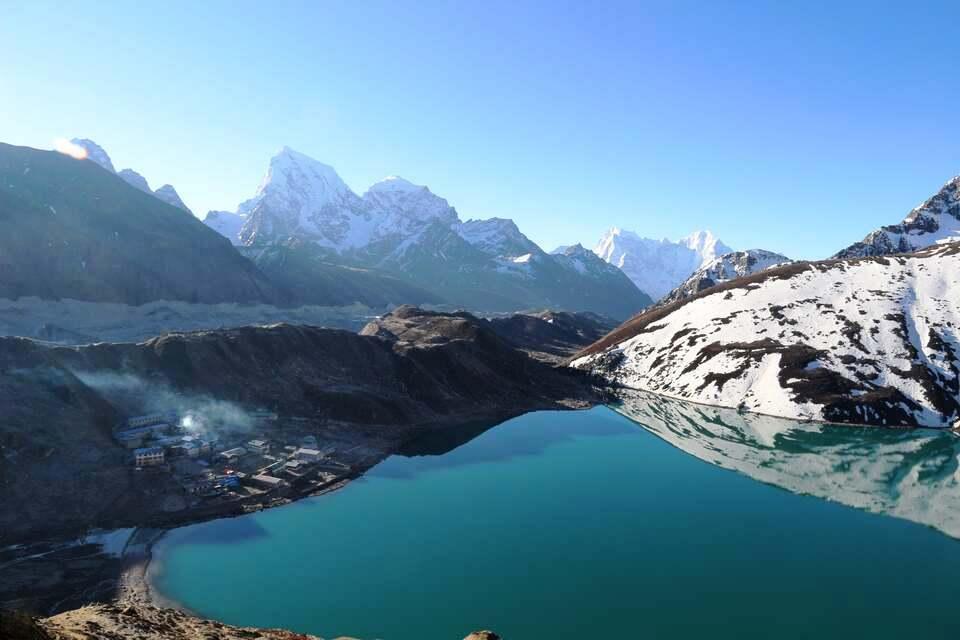Everest Base Camp & Gokyo Lake Trek
Trip at a Glance
Everest Base Camp & Gokyo Lake Trek is an outstanding Himalayan adventure in the Everest region that blends together the prime attractions of Khumbu like Everest Base Camp, Gokyo Lakes and one of the high passes namely Chola pass at 5,350 meters. Along the trekking trail one gets to witness countless Himalayan views of peaks like Mt. Everest, Lhotse, Makalu, Amadablam, Kanchenjunga, Nuptse, Mt. Pumori plus others.
Other prime highlights of the trek are enjoying the natural beauty of Khumbu, experiencing the unique Sherpa culture, trek past high mountain villages and lush forests, crossing over the high mountain passes that provide spectacular mountain views.
To set foot on the base of the world’s highest peak Mt. Everest is the dream of any adventure trekker, which this trek seamlessly offers. After attending the Everest Base Camp and hike to the popular Himalayan viewpoint Kalapathar at 5545 meters awaits another highlight of the trek i.e. crossing over one of the high passes in Khumbu, the Chola pass at 5,350 meters.
Chola Pass is an important pass in Khumbu that connects the villages of Dzongla and Thagnak. The pass is popular with amazing mountain views and one can witness peaks like Ama Dablam, Lhotse, Nuptse, Island Peak, Cho Oyu including Mt. Everest.
Trekkers will be face to face with the most beautiful Gokyo Valley in Khumbu after crossing Chola. The valley of Gokyo is adorned with Gokyo Lakes which is the world's highest freshwater lake system comprising six major lakes with Thonak Lake being the largest.
Everest Base Camp & Gokyo Lake Trek certainly is the best choice for anyone who is planning for an unforgettable Himalayan high mountain trekking that will test your physical endurance and provide you with unforgettable memories.
Everest Base Camp & Gokyo Lake Trek Highlights
- Scenic Kathmandu Lukla Flight with spectacular mountain panorama.
- Sagarmatha National Park – UNESCO World Heritage Site.
- Witness the lifestyle of people living in the high Himalayas, especially Sherpas.
- Visit the biggest monastery in Khumbu in Tengboche - Tengboche Monastery.
- Everest Base Camp & Khumbu Glacier.
- Hike to Kala Patthar with 360-degree Himalayan panorama.
- Mount Everest, Mount Amadablam, Mount Lhotse, Mount Nuptse, Mount Pumori, Island Peak, Lobuche Peak & many more.
- Conquer the majestic heights of three mountain passes over 5000 meters- the Renjo La Pass (5340 m), Cho La Pass (5350 m) and Kongma La Pass (5535m)
- Experience unprecedented bliss on the serene milieu and turquoise water of Gokyo Lake (4790m), the highest point of this trek.
Itinerary
7ay 01: Arrival in Kathmandu (1400m)
Day 02: Flight from Kathmandu to Lukla (2840m/40min) & trek to Phakding (2610/3-4hrs)
Day 03: Trek from Phakding to Namche Bazaar (3440m/5-6 hrs)
Day 04: Acclimatization day at Namche Bazaar
Day 05: Trek from Namche Bazaar to Tengboche (3860m/5-6 hrs)
Day 06: Trek from Tengboche to Dingboche (4410m/5-6 hrs)
Day 07: Rest Day In Dingboche; Hike to Chhukung (4730m) & back to Dingboche (4410m/3-4 hrs)
Day 08: Trek from Dingboche to Lobuche (4910m/5-6 hrs)
Day 09: Trek from Lobuche to Gorakshep (5140m) / Gorakshep to Everest Base Camp (5364 m) /Everest Base Camp to Gorakshep (8-9 hrs)
Day 10: Hike up to Kalapattar (5550 meters) and trek to Dzongla (4830m/6-7 hrs)
Day 11: Trek from Dzongla to Thangna (4700m/4-5 hrs)
Day 12: Trek from Thangna to Gokyo (4750m/5-6 hrs)
Day 13: Climb Gokyo Ri (5357m.) and trek to Machhermo (4470m/4 & half hrs)
Day 14: Trek from Machhermo to Namche Bazaar (3440 m/5 hrs)
Day 15: Trek from Namche to Lukla (2840m/6 hrs)
Day 16: Flight from Lukla to Kathmandu (1400m/ 40min)
Day 17: Final Departure
Arrive in Kathmandu and one of our representatives will receive you and then transfer to your hotel in Kathmandu. The rest of the time is free to explore the city where your hotel is located which is usually at Thamel – the popular tourist hub in Kathmandu where every needs and facilities for the tourist are located like hotels, pubs, restaurants, departmental stores, trek gear shops etc. Or you can simply rest at your hotel if you are jet lagged and get ready for an amazing Himalayan trek.
Wake up early in the morning and drive to the domestic section of the airport in Kathmandu for a flight to Lukla. After checking the weather it’s flight from Kathmandu to Lukla at Tenzing Hillary Airport. You will have a packed breakfast from the hotel which can be eaten while waiting for the plane at Kathmandu airport.
After a 40-45-minute flight from Kathmandu, you will finally land at Lukla and then begin your trek to Phakding –a small village in the Khumbu region. Lukla is also the place where your porters will be waiting for you. The trail goes through a green path crossing several villages like Chauri Kharka and Ghat then finally reaches Phakding for an overnight stay.
Note: Flights from Tribhuvan International Airport (TIA) in Kathmandu to Lukla and vice versa may be rerouted to Manthali during the peak trekking seasons of March, April, May, September, October, and November due to increased air traffic congestion. Manthali is 5 hours drive from Kathmandu and we need to start at 12.30am for Kathmandu/Manthali drive to catch the flight to Lukla from Manthali. During December, January, February, June, July, or August, you will experience a direct flight from Kathmandu to Lukla and vice versa.
After breakfast, the trek begins with the trail going through forests, traditional villages with ploughed fields, and yak pastures then reaches the entrance of Sagarmatha National Park from where Mt. Thamserku can be spotted.
After completing permit formalities and having lunch you will climb up to Namche Bazaar. Namche Bazaar is the gateway to the Everest region and the biggest Sherpa town in the Khumbu region where many hotels, luxury resorts, restaurants, pubs, trek shops etc are located. You name it, they have it at Namche and if you forget to shop for any trekking gear in Kathmandu, Namche is the last point to do so but the price may differ.
Today is the rest day at Namche Bazaar for acclimatization and to cope with the rising elevation. You can go for a side excursion to Hotel Everest View (3880m) which is considered the hotel located at the highest point on earth. From its balcony, you can have the first glimpse of Mt. Everest and the other world’s highest peaks while sipping tea/coffee. Then it’s back to your hotel in Namche Bazaar. In the evening, you can explore Namche, talk with the locals, and meet many other trekkers and mountaineers from around the world.
Today’s trek involves many steep ascents and descents, and it’s also a good opportunity for nice photography. On the list are Stupas (Buddhist shrines), prayer flags, mani walls (walls with Buddhist prayers carved into them), and mountains, such as Ama Dablam, and Tengboche Monastery which all are worth a good picture.
The trail up to Tengboche from Lukla is a dusty switchback path but it is all worthwhile as you reach Tengboche which offers a spectacular panorama. Tengboche has the largest Buddhist monastery which is the largest and the most important monastery in Khumbu. Pay a visit to the monastery and with a small donation, you can light some butter lamps.
The trail is quite challenging today but with a very scenic route. The trail follows the Imja Khola ‘River’ climbing up to Dingboche and passing along windswept fields (mainly potato). Dingboche is the highest Sherpa village in Khumbu. The view of AmaDablam is spectacular from Dingboche which arrived during lunch time. After lunch at Dingboche, the rest of the afternoon is free to explore watch the surrounding Himalayas or dig into your books. etc
As the altitude increases it’s important to get better acclimatization so it’s rest/acclimatization day at Dingboche. You can rest at your lodge or there are several side excursions like a hike to Nangkar Tshang Peak, with its sacred sites and views of Mt Makalu. Or hike to Chhukung (4,730 m) which provides majestic views of Mt. Lhotse, Mt. Makalu and Mt. Choyo. You will also notice Imja Khola Valley as well as the fields and pastures of Dingboche. Afterwards, back to the lodge at Dingboche
Today you will gently climb to the Pheriche Valley and then trek above the valley floor passing along alpine scrub and yak pastures. En route get a good view of Tawoch and Cholotse, with Ama Dablam behind us. From here you will notice as if AmaDablam is just rising from the valley floor.
Then you will continue to Thokla Pass, where the ascent is challenging. From here is another good opportunity for the best photos of the peaks like Nuptse, Lhotse, Lhotse Shar, and a few other 7,000-plus meter peaks. After crossing this pass will finally reach Lobuche. Lobuche isn’t a big town but is surrounded by dramatic and beautiful surroundings.
Today is the big day as you will be attending Everest Base Camp, the foot of Mt. Everest. You will start first with 3 hours hike to the small village of Gorekshep passing over boulders and rough terrain.
Then hike to Everest Base Camp and upon arrival feel the majesty of the base camp, walk over the Khumbu Glacier from where Everest summiters start their journey to the top. Celebrate your achievement with your trek guide and other members at the base camp. From the base camp enjoy views of Khumbu Icefall, Khumbu Glacier, Nuptse, Pumori, Khumbutse, and a little bit of Everest. Afterwards, back to Gorekshep for the overnight stay.
Hike early in the morning to Kalapatthar to witness sunrise views over the Himalayas. The hike from Gorekshep to Kalapatthar viewpoint is about an hour going uphill. From its summit enjoy spectacular views of peaks like Mt.Pumori, Mt. Everest, Mt. Nuptse, Mt. Lhotse and others.
Then hike back to Gorekshep for breakfast and hike continues downhill to Dzongla losing more than 1000 meters. Soon the village of Dzongla is reached for the overnight stay. Today is the longest trek day about 6-7 hours.
Trek begins after breakfast where the path is a level track at first. Walking further through fields will take you to a parched valley. Then begins the quite challenging trek with the path to Cho La Pass which is a steep and icy uphill walk. Then the trail descends to Phedi on a different path. After walking for a few hours will reach Thangna. The old-fashioned village of Thanga offers a great mountain panorama including Machhermo Peak.
The trek begins with ascending upwards on the wall of the valley to enjoy spectacular mountain views. In winter you will enjoy white panorama all over the region. You should take your steps carefully as there might be crevasses along the route as you will be walking on the Ngozumpa Glacier – the longest glacier in the Himalayas, below Mt Cho Oyu- the sixth-tallest peak in the world. Soon the beautiful lake of Gokyo is reached. Explore around the lake walking at its shore looking at the blue water, enjoying the cold wind and the mountains around the lake.
Early in the morning hike to Gokyo-Ri, another popular Himalayan viewpoint in Everest, then to Machhermo via Gokyo village. Gokyo-Ri is above the village on the northern edge of the lake. Climbing up to Gokyo-Ri the sights of Everest, Lhotse and Makalu slowly come into view and from its summit as well. Some even say that the view from Gokyo-Ri is even better than Kala Patthar. After Gokyo-Ri trek to Machhermo.
Today is trek from Machhermo to Namche Bazaar taking about 5 hours. The trail today gently descends with a crossing over Dole then again descends steeply to Photse Tenga (3650m) passing through rhododendron forests. Then, the path immediately ascends steeply to Mongla Danda (4,000 m.) and gently descends up to Kyanjoma (3500m.) following a small up and down trail to Namche Bazaar.
It’s the last day of the trek and you head down from Namche Bazaar to Lukla from where you first started your trek to Everest. Today is the distance you covered in three days at the early stage of the trek and it should not be tough since it is downhill to Lukla. Make the most out of your day today. Lukla is reached after 6 hours of walking and check-in lodge for the overnight stay.
Bid farewell to the Everest region and the mountain, and take again the trans-Himalayan flight back to Kathmandu to Lukla. The Himalayas slowly fade from your plane window screen and finally land at the airport in Kathmandu. Then drive to a hotel in Kathmandu. The rest of the time is free to explore or simply rest at your hotel.
The trip concludes and our office representatives will take you to the international airport in Kathmandu to catch your onward flight to your next destination or fly back home. You need to be at least 3 hours before your flight time at the airport.
Thank you for visiting Nepal and we hope your Himalayan Holiday has come true. Have a safe flight back home!
What is included?
- Airport pick-up and drop services.
- Hotel accommodations in Kathmandu on Twin-Share Basis with breakfast.
- Kathmandu/Lukla/Kathmandu round airfare.
- All trekking accommodations with Breakfast/Lunch/Dinner at local lodges.
- Four seasonal sleeping bags and duffel bags (to be returned after trip completion).
- A comprehensive medical kit (will be carried by the trekking guide).
- Experienced Government licensed English Speaking Guide & Porter (1 porter for two people) including their food, accommodation, salary & insurance.
- Permits for Everest National Park, Khumbu Municipality and TIMS (Trekkers' Information Management System).
- Farewell Dinner at Nepali Authentic Restaurant.
- All government and local taxes.
What is not included?
- International airfares.
- Nepal entry visa fee – Visa can be obtained upon your arrival at the Tribhuwan International Airport in Kathmandu. (USD30 for 15 days)
- Lunch & dinner in Kathmandu.
- Personal travel insurance.
- Emergency rescue evacuation (to be covered by the client's travel insurance).
- Excess baggage charges (luggage allowance for domestic airlines in Nepal is 15 kgs.)
- Expenses of a personal nature (phone calls, laundry, battery recharge, bottle or boiled water, hot shower etc.)
- Cost incurred due to the addition of extra days or change in the itinerary due to bad weather, political turmoil or any other unforeseen contingencies.
- Bar bills, alcoholic drinks & beverages.
- Tips to the guide and porters (Tipping is expected).
Route Map
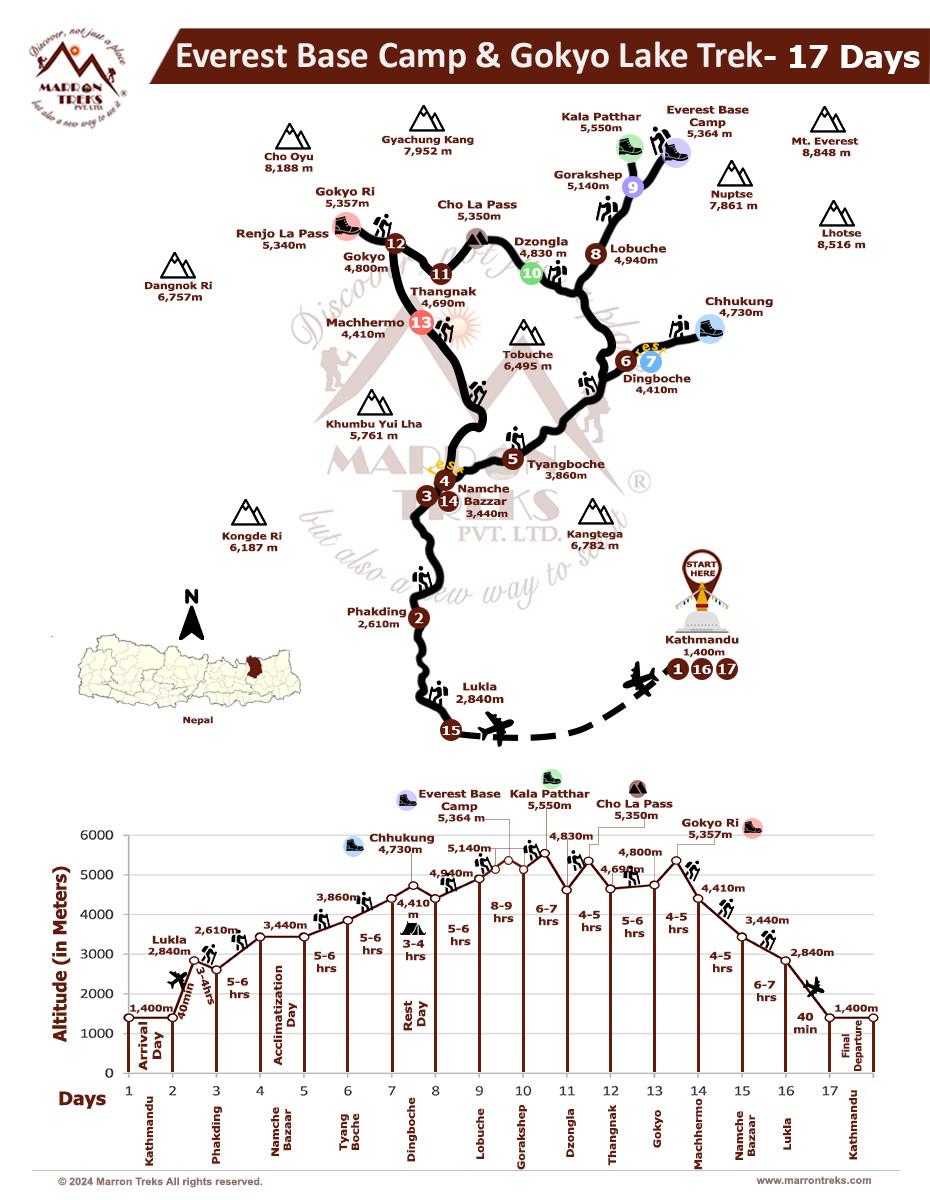
Trip Info
Accommodation
While you are in Kathmandu, we opt to accommodate you in 4- or 5-star hotels like Hotel Royal Singhi (4-star), Hotel Manaslu (4-star), Radisson (5-star), Yak & Yeti (5-star), or similar. During the trek, you will be accommodated in a local mountain lodge, better known as Tea House. These lodges and teahouses provide good services and are equipped with basic amenities. We will endeavor to provide you with the best accommodation available along the route so that you get a good night’s rest in a hygienic milieu.
Meals
We never compromise the quality of food or the health of the trekkers as well as the crew members. Generally, we opt for the fresh and nutritional local community food available. You could make your delicious pick from an array of traditional foods like Sweet potatoes, buckwheat barley, etc. This way, you could not only get a real sense of the local culture and life patterns but also contribute to promoting the locally available resources of organic food and beverages. Besides, a wide range of Continental, Chinese, Italian and Indian cuisines like Pizza, Spaghetti, French Fries, Soups, Breads, Masala curry, etc. are also available in the restaurants for your retreat.
Acclimatization
Altitude sickness is a serious risk while trekking in the Himalayas. It's important to acclimatize properly by spending a few days at lower altitudes before heading higher. By spending time at lower altitudes before pushing higher, your body has time to adjust. Our trekking packages have enough acclimatization days planned where you'll be spending a day or two at lower altitudes, allowing your body to adjust to the increasing altitude.
Electricity & drinking water
For an additional cost, you can use the electricity in all tea houses and lodges to recharge your batteries. The lodges have packaged mineral water for sale, or you can fill your bottle with boiling water. To make water drinkable, you can use water purification tablets too. But, due to hygienic issues, you should avoid drinking water from taps, rivers, or wells in trekking areas.
Communication
At lodges, restaurants, and hotels, Wi-Fi is available for an additional fee in the most popular trek regions, like Everest, and Annapurna. However, at high elevations, phone calls are the only means of connection. Our office in Kathmandu is in constant communication with your trek guide. In Kathmandu, you can purchase a local sim card for communication purposes. At high elevations, the mobile signal might not be as strong, though.
Luggage
Our porters are paired with one trekker for every two hikers, and one porter can safely carry 30 kg maximum weight. Therefore, we advise you to fill your duffle bag not more than 15 kg with your belongings. You may carry a small backpack with your valuables and informational documents. The things you are not taking along on the trek can be stored in a hotel in Kathmandu free of cost.
Typical Trek Day
Mostly your trek day starts with breakfast at 7-8 am, followed by a 3-4 hour morning trek. Lunch break is around an hour, then you continue trekking to your destination for the day. After reaching the teahouse lodge, you can relax, explore nearby areas, and enjoy dinner at 6-7 pm. Evenings involve socializing, a trek briefing, and leisure activities before bed.
Travel Insurance
It is advised that you arrange your travel insurance before leaving your homeland. The main thing is to make sure that your insurance covers you for both- medical and evacuation costs. Having travel insurance with you makes your trip secure and hassle-free.
Our Guides
Guides play a significant role during the trek. They are the ones who literally decipher the trekking codes for you so that you can actually connect with nature, culture and people along the way. We have helpful and dedicated trekking guides who are very well-versed in the culture, life patterns and every single detail pertaining to the trek region you are traveling in. Thus, in the company of our professional Sherpa guides, your trek becomes not only entertaining but also equally informative.
Porter and Staff Care
When it comes to high-altitude trekking, porters and staff members make up a pivot. Marron Treks ensures that all the porters and staff members going to high altitudes are provided with adequate clothing and equipment. All our field staff are covered by insurance.
